|
Gouldian Finch
Erythrura gouldiae , Chloebia gouldiae (Gould, 1844)
Authors (Gerhard Hofmann, Fernanda Scheffer & Claudia Mettke-Hofmann)

Genetics head-color pdf for printing (German)
The first Gouldian finches arrived already 1877 in Europe. Every aviculturist wanted to get hold of them but for most breeders they were way too expensive and remained a dream. The success story of this elusive species began 1960 with the export-ban launched by the Australian government. There were no longer imports available and the bird breeders all over the world worked hard to build up a sustainable population in their cages and aviaries. In fact they did a pretty good job. Whereas in the old days ‘… I am looking for …’ was the most common term you could read in the journals, nowadays it has changed radically to ‘… parent bred Gouldians for sale …’. Today, Gouldians are still among the most popular but now also most common finches in captivity; even beginners are able to keep and breed this formerly so delicate species.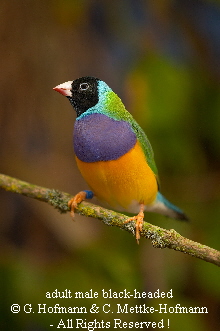
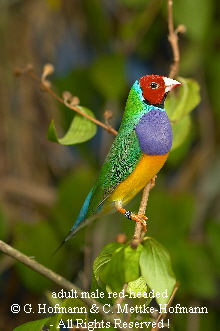 It was a long way until the Gouldians lost their status as problematic species which could create all kind of difficulties for the breeder. Fourty years of diligent breeding effort and selection for the healthiest birds led to the healthy and hardy breeding stock we can find these days and this without any more care required than for most of the other Estrildian finches. It was a long way until the Gouldians lost their status as problematic species which could create all kind of difficulties for the breeder. Fourty years of diligent breeding effort and selection for the healthiest birds led to the healthy and hardy breeding stock we can find these days and this without any more care required than for most of the other Estrildian finches.
Still the behavior of Gouldians depends highly on the circumstances how they are kept. At low temperatures or when housed as a single pair they can be quite inactive, still a beauty but certainly not the most interesting species to observe. But it’s a different story when they are housed in a well structured aviary in a small flock at adequate temperatures. Suddenly, they are among the liveliest and most interesting finches one can imagine. Of course Gouldians can be housed in cages and as a matter of fact probably most birds are born and reared in breeding cages but the best would be a combined in- and outdoor aviary to enjoy the full beauty of the species. Although there are differences in temperature sensitivity between different breeding stocks the birds still prefer the warmer temperatures. After all we keep birds because we like them; let’s make their life a little bit more comfortable and don’t house them below 20°C over a long period. Gouldians even breed when they are housed as a single species flock but to avoid running into trouble the aviary has to be big enough and should be divided in a nesting corner with all the nest boxes (roughly twice as many as pairs in the aviary is a good way to avoid fighting over nestboxes) and a social feeding area. The social area should be structured with some denser corners with enough twigs to sit on. Our birds like willow- and birch-twigs a lot. The more open area is reserved for feeding and for flying longer distances.
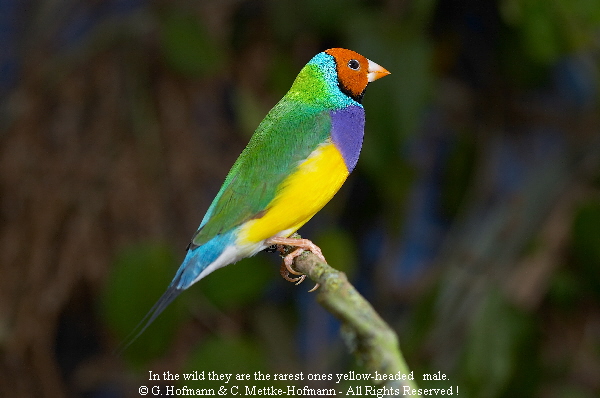 |
Usually Gouldians get along pretty well with other birds; It doesn’t matter whether it’s the own species or another species. After an acclimatization period Gouldians get quite tame and they nearly never show the shyness known from their relatives the parrot finches and munias.
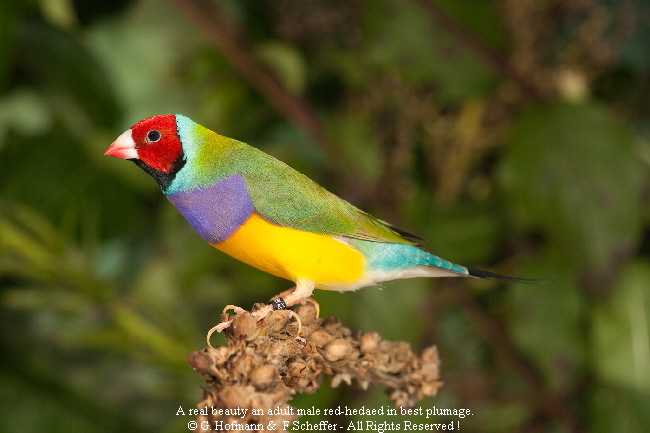 |
But as so often the optimum will remain a dream for the majority of breeders. Most of us will keep them in the typical breeding cages but even here we can make life more pleasant for the birds: The first thing to do is certainly to choose a cage which is not too small. We use 1m x 0.5m x 0.5m as the smallest size. Keep in mind that after fledging this cage will be home for approximately six birds. It’s certainly never too big … a cage can’t be too big, can’t it? The cage has in any case to be big enough so that the birds can fly a little at least. Most pairs will accept a nest-box fixed at the outside of the 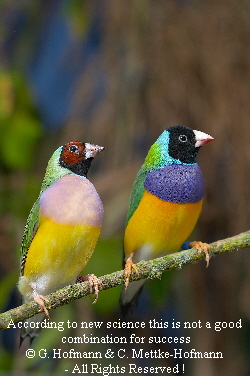 cage which gives a little bit more space and makes controlling the nest easier. cage which gives a little bit more space and makes controlling the nest easier.
The nutrition for the Gouldian is not more difficult than for other finches - actually it is easier as they are mainly vegetarians which don’t depend on live food. This certainly helped to make them so popular among private bird lovers. Our Gouldians have a preference for a couple of different seeds. They like Japanese, Manna-, White- and Black millet as well as the always popular spray-millet. Canary seed and meadow grass as well as orchard grass are other favorites of our birds. In former days, we custom-made the food for our birds. Luckily we don’t have to do it any more our food-supplier BLATTNER offers two excellent mixtures for Gouldians one for the breeding season, another especially for the non-breeding season … keeping and breeding birds is a lot easier than in the old days. Additionally, our birds get a mixture from the same company consisting of different grass seeds. For rearing the young we use the breeding mixture but also offer it germinated and mix the germinated seeds either with peat or bird-soil. Half-ripe millet like spray- or white-millet is another part of our birds’ nutrition for rearing their chicks.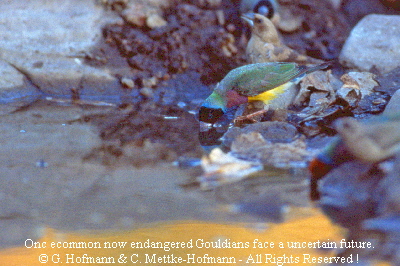
They also like milky half-ripe grass-seeds like Meadow and Ray grass and chickweed and all the wild millet sorts growing on the fields. Egg food is not a favorite among our birds and this is not surprising. Research by SONYA TIDEMANN showed that they nearly only feed on different Sorghum-grass seeds. Even for rearing their young they don’t switch to insects. We offer our birds a mixture of Nekton Tonic-K and Orlux egg food for finches, but not all our birds accept it. The one which don’t accept it seem to do equally well as the birds which eat the egg food. In any case we pay attention that our Gouldians don’t eat too much of it - less is better than too much.
During the non breeding season we change the diet for our birds. Goodies like half-ripe or germinated seeds are offered only occasionally. The same is true for the egg food. We switch from the breeding mixture to the less nutritous non-breding mixture. Minerals like grit, egg-shells or bird-soil are offered all year round. The juveniles also get plenty of millet spray after they are seperated from their parents but we cut it back after they finished the molt.
Even with a good nutrition Gouldians, particularly freshly fledged or molting juveniles, can get sick. They are very susceptible for air-sack mites and avian pox. The latter can wipe out a whole breeding stock in two days whereas other finches like painted firetails or African firefinches kept in the same aviary don’t show the slightest sign of sickness. Changes are something Gouldians really don’t like; they prefer a predictable life and stick to their habits, to move them to other aviaries or sudden changes in daylight hours are stressful for them. This can sometimes trigger diseases the birds carry already inside for a long time but could cope with until this stressful event.
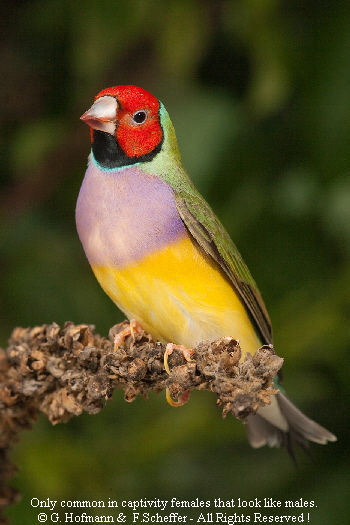 |
Gouldian finches are among the most reliable and diligent birds when it comes to rearing their offspring; we rarely had pairs failing to raise their chicks. They mostly were an example for a perfect breeding pair rearing brood after brood, year after year. When the birds fail it is mainly because of wrong nutrition, too low temperatures or the partners don’t get along with each other. SARAH PRYKE could show that even the color of the head has an influence on the breeding results. In her studies pairs with mixed head colors ( black headed x read headed or the other way round) laid less eggs, invested less in rearing their offspring and produced more males than pairs were both sexes had the same head color. One of the main requirements to be a successful bird breeder is patience and it pays to wait until the breeding pairs are old enough or in good breeding condition. Often beginners don’t have the patience and start right away - sadly in most cases with little success. 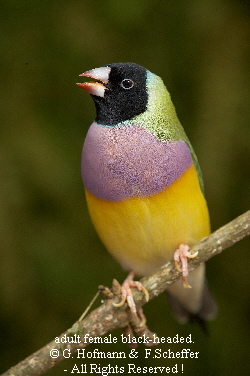
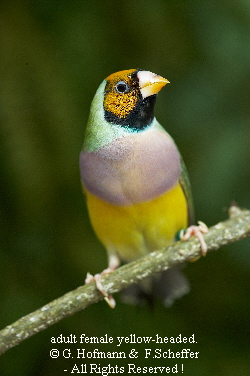 From all Australian finches Gouldians are the one which nearly always breed in cavities. They nearly never build their nest in dense scrub. No wonder that they like the typical nest-boxes for finches or budgerigars. In either case it is important that the nest is big enough (not smaller than 15x15x15cm) which is usually the case with the budgerigar nest-boxes. Nearly all pairs like to build their nest as high as possible so that we should do them this favor and fix the nestboxes at the highest place in the aviary or cage. When the birds are housed as a flock there should always be more nest-boxes provided than pairs in the aviary. It helps to keep a certain distance between the nest-boxes and to provide some cover from the other boxes. Gouldians seem to be highly susceptible for imprinting; As adults they prefer they type of nest-box they were reared in. The same applies for the nesting material. When we buy new birds we always have a look what kind of nest-box the breeder provides and what kind of nesting material the birds get in their cages. If the new bought birds hesitate to breed in the nest we provide we use the one from the breeder. We had very few pairs which were really lousy builders and they would probably lay the eggs in the empty box if we had not provided some coconut-fibres in the nest, but this is not the normal case. Normally they build their nest like all other finches. They usually like coconut-fibres and fine grass. Like parrot finches and munias Gouldians don’t line the chamber with feathers. Shortly after finishing the nest they will lay the first egg. The clutch size is normally four to six eggs occasionally even eight or more but from such big clutches only a small fraction will hatch. To prevent egg-binding we dust the dry seeds with Nekton MSA (Calcium Vitamin D3 food supplement) and make sure that the birds always have access to crashed sterilized eggshells. From all Australian finches Gouldians are the one which nearly always breed in cavities. They nearly never build their nest in dense scrub. No wonder that they like the typical nest-boxes for finches or budgerigars. In either case it is important that the nest is big enough (not smaller than 15x15x15cm) which is usually the case with the budgerigar nest-boxes. Nearly all pairs like to build their nest as high as possible so that we should do them this favor and fix the nestboxes at the highest place in the aviary or cage. When the birds are housed as a flock there should always be more nest-boxes provided than pairs in the aviary. It helps to keep a certain distance between the nest-boxes and to provide some cover from the other boxes. Gouldians seem to be highly susceptible for imprinting; As adults they prefer they type of nest-box they were reared in. The same applies for the nesting material. When we buy new birds we always have a look what kind of nest-box the breeder provides and what kind of nesting material the birds get in their cages. If the new bought birds hesitate to breed in the nest we provide we use the one from the breeder. We had very few pairs which were really lousy builders and they would probably lay the eggs in the empty box if we had not provided some coconut-fibres in the nest, but this is not the normal case. Normally they build their nest like all other finches. They usually like coconut-fibres and fine grass. Like parrot finches and munias Gouldians don’t line the chamber with feathers. Shortly after finishing the nest they will lay the first egg. The clutch size is normally four to six eggs occasionally even eight or more but from such big clutches only a small fraction will hatch. To prevent egg-binding we dust the dry seeds with Nekton MSA (Calcium Vitamin D3 food supplement) and make sure that the birds always have access to crashed sterilized eggshells.
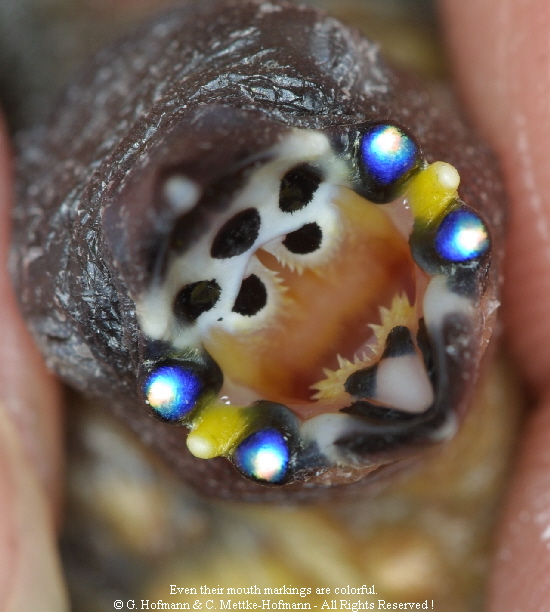 |
The incubation lasts for 14-15 days which does not differ from other Estrildians. Nearly all pairs we had didn’t care when we controlled the nests or banded the nestlings. The only exception are young pairs breeding for the first time. They usually need a little longer before they return to the nest. As it is always better to be safe than sorry we only control when it is n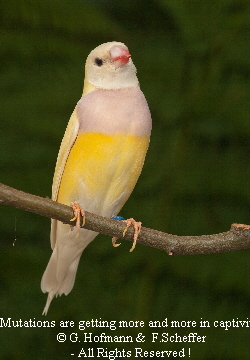 ecessary and don’t overdo it. ecessary and don’t overdo it.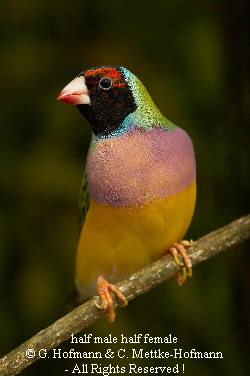
The chicks nearly all hatch at the same time with mostly less than one day difference between the first and the last one. A critical period is around day ten when many females don’t sleep in the nest at night any more so that the chicks depend solely on their own thermo regulation. To be safe the temperature should not drop below 20° C at night although if there are three or four youngsters in the box they will survive colder nights as well. With single nestlings it’s a different story.
Like most Estrildians Gouldians fledge at around day 21 to 22. The first couple of days, the father sometimes leads them back to the nest for the night. But the rule is that they sleep outside the nest very soon after fledging. Two or three days after they have left the nest they try to feed for themselves but will still depend for about two more weeks on their parents. We don’t separate the juveniles from the parents before at least three weeks after fledging. When they are housed in a bigger aviary we let them stay with the parents until they finish the first molt. They start to molt when they are six to eight weeks old and are usually done with it when they are around 4 months old. Many birds need longer in particular when they are kept at low temperatures or low light conditions. As with nearly all finches it is wise to prevent breeding below one year of age and of course two to three broods should be the limit per season.
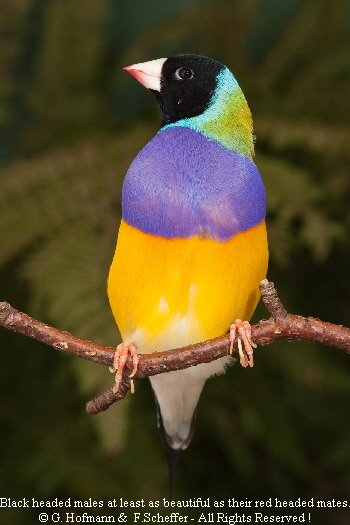 |
All images and text and are Copyright © 2007 of Hofmann-photography and may not be used without the permission of the authors
|